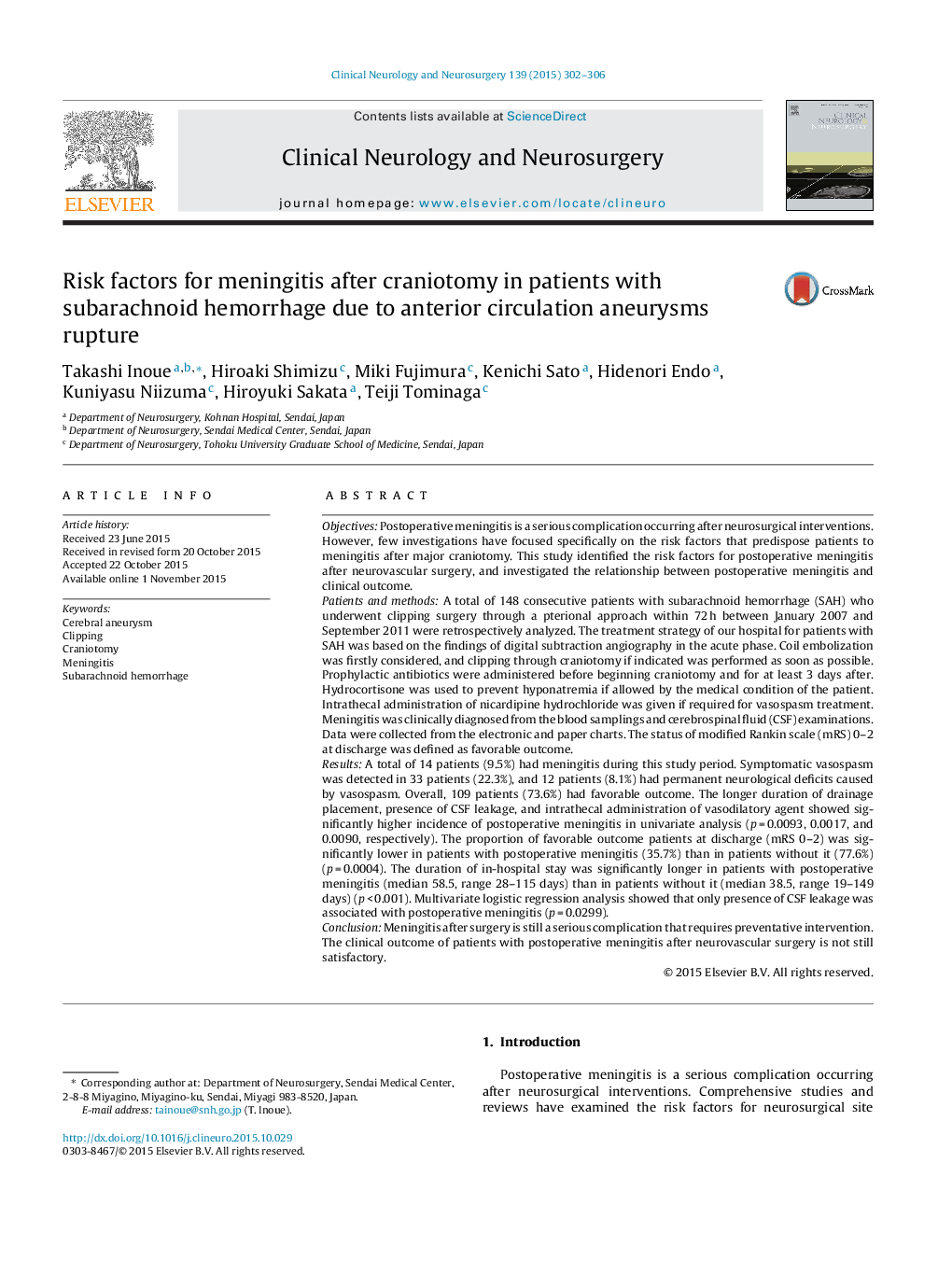| کد مقاله | کد نشریه | سال انتشار | مقاله انگلیسی | نسخه تمام متن |
|---|---|---|---|---|
| 3039800 | 1579683 | 2015 | 5 صفحه PDF | دانلود رایگان |
• The risk factors for meningitis after neurovascular surgery were investigated.
• The meningitis was a high risk factor for poor outcome.
• The patients with meningitis stayed longer in hospital.
• Only presence of CSF leakage was associated with postoperative meningitis.
ObjectivesPostoperative meningitis is a serious complication occurring after neurosurgical interventions. However, few investigations have focused specifically on the risk factors that predispose patients to meningitis after major craniotomy. This study identified the risk factors for postoperative meningitis after neurovascular surgery, and investigated the relationship between postoperative meningitis and clinical outcome.Patients and methodsA total of 148 consecutive patients with subarachnoid hemorrhage (SAH) who underwent clipping surgery through a pterional approach within 72 h between January 2007 and September 2011 were retrospectively analyzed. The treatment strategy of our hospital for patients with SAH was based on the findings of digital subtraction angiography in the acute phase. Coil embolization was firstly considered, and clipping through craniotomy if indicated was performed as soon as possible. Prophylactic antibiotics were administered before beginning craniotomy and for at least 3 days after. Hydrocortisone was used to prevent hyponatremia if allowed by the medical condition of the patient. Intrathecal administration of nicardipine hydrochloride was given if required for vasospasm treatment. Meningitis was clinically diagnosed from the blood samplings and cerebrospinal fluid (CSF) examinations. Data were collected from the electronic and paper charts. The status of modified Rankin scale (mRS) 0–2 at discharge was defined as favorable outcome.ResultsA total of 14 patients (9.5%) had meningitis during this study period. Symptomatic vasospasm was detected in 33 patients (22.3%), and 12 patients (8.1%) had permanent neurological deficits caused by vasospasm. Overall, 109 patients (73.6%) had favorable outcome. The longer duration of drainage placement, presence of CSF leakage, and intrathecal administration of vasodilatory agent showed significantly higher incidence of postoperative meningitis in univariate analysis (p = 0.0093, 0.0017, and 0.0090, respectively). The proportion of favorable outcome patients at discharge (mRS 0–2) was significantly lower in patients with postoperative meningitis (35.7%) than in patients without it (77.6%) (p = 0.0004). The duration of in-hospital stay was significantly longer in patients with postoperative meningitis (median 58.5, range 28–115 days) than in patients without it (median 38.5, range 19–149 days) (p < 0.001). Multivariate logistic regression analysis showed that only presence of CSF leakage was associated with postoperative meningitis (p = 0.0299).ConclusionMeningitis after surgery is still a serious complication that requires preventative intervention. The clinical outcome of patients with postoperative meningitis after neurovascular surgery is not still satisfactory.
Journal: Clinical Neurology and Neurosurgery - Volume 139, December 2015, Pages 302–306
